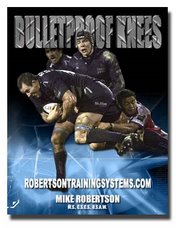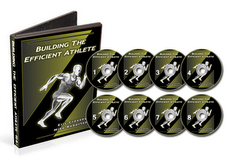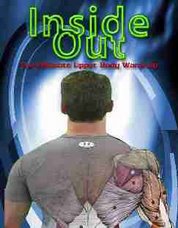
Ok, the title has absolutely nothing to do with the post, but that's what happens when you spend too much time in your gym!
Here are 5 knee health tips I gave to Eric Cressey for his recent newsletter. If you aren't signed up, why not? My man is wicked smart and he's always got great content in his newsletter. Enjoy!
Here are 5 knee health tips I gave to Eric Cressey for his recent newsletter. If you aren't signed up, why not? My man is wicked smart and he's always got great content in his newsletter. Enjoy!
------------------------------------------------------------------------------------------------
5 Keys to Bulletproofing Your Knees
1. VMO specific work is currently poo-poo in the strength and conditioning industry. While I agree that we need to focus on strengthening the hip abductors/external rotators (especially glute max and posterior glute med), current literature leads us to believe that there’s more to the VMO than we might have expected.
1. VMO specific work is currently poo-poo in the strength and conditioning industry. While I agree that we need to focus on strengthening the hip abductors/external rotators (especially glute max and posterior glute med), current literature leads us to believe that there’s more to the VMO than we might have expected.
Several studies in the past two years have indicated that there is a definite change in fiber pennation between the vastus medialis longus (VML) and the vastus medialis obliquus (VMO). Beyond that, while your other quad muscles like rectus femoris and vastus lateralis only have one motor point, the entire vastus medialis actually has THREE motor points!
We may not totally understand the VMO yet, but I’m not willing to write off its importance with regards to knee health.
2. When looking at the body as a functional unit, we can’t overlook the core with regards to knee health. More specifically, we know the rectus abdominus and external obliques work to keep us in pelvic neutral and out of anterior pelvic tilt. Lack of strength in these core muscles increases anterior pelvic tilt, which drives internal rotation of the hip and valgus of the knee. Getting and keeping these muscles strong could go a long way to preventing knee injuries, especially in female athletes.
3. Are accelerated ACL rehab programs what we need? I’m not so sure, and I think making young athletes follow the accelerated programs the pros use may do more harm than good.
Unlike the pros that are getting paid to play, we need to focus on the long-term outcomes of our young athletes, not simply getting them back on the field ASAP. Many have done an excellent job of rehabbing patients and getting them back on the field quickly, and quantifying strength and power production/absorption is critical.
Many of the leading PT’s and orthos, however, are moving back to a slightly more conservative approach to allow the graft itself more time to heal. The properties of a tendon graft slowly take on the properties of a ligament over time; this is called ligamentization. However, ligamentous changes can still be seen as late as 12-18 months post-surgery.
[Note from EC: so, if you have a patellar tendon graft for a new ACL, you might not really have what you want until 1-1.5 years post-surgery. Tendons and ligaments have different qualities.]
4. To piggy-back on the previous point, another factor that isn’t examined as often as it should is long-term outcomes of ACL rehabbed clients. Sure it’s great to get them back on the field in 6, 9 or 12 months, but what are the long-term ramifications?
We know that females who have suffered ACL tears are much more likely to develop early osteoarthritis. If we can improve long-term outcomes by keeping them out a little longer, isn’t that worth it? As a PT or strength coach, it’s our job to help clients/athletes make the best decision for their long-term health, especially if they are too young to understand the long-term repercussions of their decision.
5. When an athlete tears their ACL, proprioceptive deficits are seen as quickly as 24 hours post-injury. What’s really intriguing, however, is that we often see this same deficit carried over to the healthy knee as well! Even after reconstruction this deficit can be seen for up to six years.
To counteract this, don’t forget to include basic proprioceptive training (barefoot warm-ups, single-leg stance work, etc.), and train that “off” leg in the interim.
If you like this tips and want more, be sure to check out my Bulletproof Knees manual.
Stay strong
MR









No comments:
Post a Comment